
New research commissioned by Fairsail has revealed that HR managers have to cope with five generations of employees. The research was commissioned from Multigen research and can be downloaded here (registration required). A survey polled 250 HR leaders across the UK and US focusing on the challenges of managing today’s diverse workforce.
Five generations of workforce.
The report entitled 17-70 delivers some interesting findings. People are working longer than ever before. There are now five generations or workers, Traditionalists, Baby Boomers, Generation X, Millennials (Generation Y) and Generation Z. The report does little to define the actual breakdown of different generations and there are many academics who ponder over the exact date
For example generation Z is cited as starting from as early as 1990 (Tulgan), to 1994 (McCrindle and Wolfheimer) to as late as 2000 by some. In fact these different generations are often based on their early life experiences and therefore their outlook on the world. Generation Z were born with a smartphone in their hand and are becoming a “gig” workforce. They have very different requirements from other generations.
Is it just generational?
The survey delivers a key finding around this diversity. Millenials are the most challenging to manage (47.6%) followed by Baby boomers (33.6%). It will be interesting in a few years time to see whether Generation Z employees have overtaken generation Y as hardest to manage. The “gig” workforce is growing and as companies look to adopt this they find that the older generations who desire more stability want different things.
It is a shame that the survey is not supported by qualitative evidence that delved deeper into this. One factor that may be influencing this change is the fact that it is now taking longer for people to get on the housing ladder. The Office of National Statistics (ONS) showed that in 2011/12 a mere 10% of 16-24 years owned a house, compared to 22% in 2001/2. Only from the age of 45 does the percentage of ownership start to be similar with historic years.
Challenges for HR leaders

What this does bring for HR Leaders are additional challenges. 22% of HR Leaders found the difference practices required an issue. Adam Hale, CEO of Fairsail commented: “Businesses today are navigating uncharted territory, managing people each with their own needs, preferences and developmental opportunities. This can create a high level of uncertainty around how to hire the best talent of any age while providing all employees with the necessary support to perform at their best. More than ever before, HR leaders need to think like people scientists in order to optimize both talent management and business outcomes.”
The survey reveals several steps to meeting this challenge. HR Leaders are looking to data science and analytics to understand who their workforce is. They are looking to modern technology to resolve the problem, with digital HR (66.4%), behavioural economics (66%) and cognitive computing (63%) all providing answers.
The most pressing problem is finding the right workers. 94% of respondents struggle to recruit people with the necessary skills. Digital skills are also in short supply with 22% having difficulty recruiting to relevant positions. Fairsail recently announced the launch of its Wave Analytics solution for HRM to meet this challenge. The challenges are similar on both sides of the Atlantic although the report does pull out some nuances.
The growing importance of HR
One statistic the survey also revealed was the growing importance of HR. More than two thirds (68%) of respondents now report directly to the CEO. What it didn’t reveal was how many of them actually have a seat at the leadership table. The inference is that this is an increase from a few years ago. Certainly HR is becoming more strategic.
In a blog for the Wall Street Journal last year Lynda Spiegal wrote about why HR belongs in the C-Suite. It seems that more CEO’s are paying attention. She mentions that improving engagement, the role of G#HR Leaders can have a significant benefit to companies. Spiegal wrote: “transforming low engagement can have an impact of over $42 million in a company of 10,000.”
Conclusion
HR leaders are becoming more reliant on HR solutions to keep track of and management companies employees. This is to Fairsails’s benefit. Hale commented: “With different generations working alongside each other, businesses must ensure they have the right tools and strategies to manage their teams effectively. And as the workforce continues to evolve, success will be contingent upon having full visibility of all employees, their skills and where they need additional support. This is especially true with multi-generational workforces where factors such as a digital skills and the need to build effective leadership pipelines further complicate the talent management process.”
It is those tools that Fairsail provides, though there are of course other solutions out there.


























